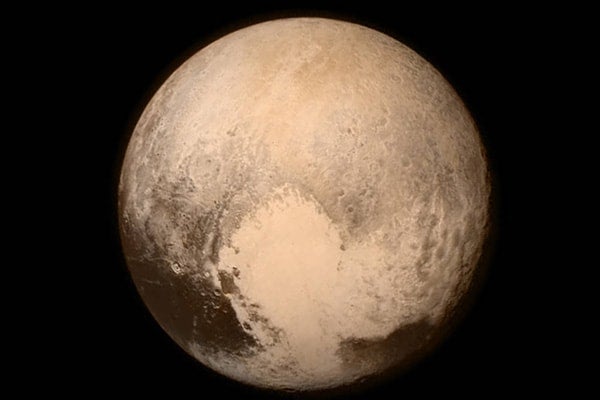
Hello Pluto: why NASA's New Horizons travelled 4.7 billion kilometres just to see a former planet
Published: July 14, 2015
On July 14, 2015 the New Horizons spacecraft sped past the dwarf planet Pluto at 14 km per second, after a nine-year journey of almost 5 billion kilometres.
The probe contains an array of scientific equipment which will provide scientists with a wealth of data and give us the most detailed images yet of the distant world.
Researchers are looking forward to the images New Horizon will send back, including glimpses of Pluto's moons: five moons: Hydra, Kerberos, Nix, Styx and Charon. Already the mission has revealed that Pluto is bigger (slightly) than previously believed. What else can we learn?
U of T News asked Christa Van Laerhoven, an astronomer with the Canadian Institute for Theoretical Astrophysics at the University of Toronto, about the mission. Her research focuses on the family of solar system objects to which Pluto belongs: the Kuiper Belt objects that reside beyond the orbit of Neptune.
When New Horizons started on its journey in January 2006, Pluto was still a full-fledged planet. Now it's a dwarf planet. What happened?
Pluto is a member of the Kuiper Belt, a collection of icy bodies which orbit beyond Neptune. Just over 60 years elapsed between the discovery of Pluto and the discovery of the next Kuiper Belt Object (KBO), but today we know there are tens of thousands bigger than ~100km. With the discovery of Eris, which is more massive than Pluto, it became clear that either Pluto should not be considered a planet, or that Eris and others should also be called planets.
 When the International Astronomical Union reclassified Pluto as a 'dwarf planet' in 2006, it recognized that Pluto inhabits a middle ground between the eight major planets and the small bodies of the solar system. Like the major planets, Pluto is massive enough to have pulled itself into a sphere. Like the small bodies of the solar system, Pluto doesn't gravitationally dominate other things with similar orbits.
When the International Astronomical Union reclassified Pluto as a 'dwarf planet' in 2006, it recognized that Pluto inhabits a middle ground between the eight major planets and the small bodies of the solar system. Like the major planets, Pluto is massive enough to have pulled itself into a sphere. Like the small bodies of the solar system, Pluto doesn't gravitationally dominate other things with similar orbits.
The same sort of reclassification happened to Ceres and other asteroids after more and more asteroids were discovered. Regardless of what we call it, Pluto is fascinating.
(At right: Christa Van Laerhoven in Hawaii to visit the Mauna Kea Observatory.)
Pluto is small and very far away. Why is it so important we study it?
Pluto is the first KBO that we have sent a spacecraft to. It's the first non-moon, non-comet, predominantly icy body we get to study up close. The goal is to better understand the processes at work on planets and dwarf planets. For example, better understanding of Pluto's atmosphere helps us understand other planets' atmospheres, including Earth's.
Imagine trying to understand everything about apples when you only have a Granny Smith apple. We need to study other delicious apples – I mean, planets, to really understand our own. What's the same? What's different? How did our solar system form so we got Earth and we got Pluto too?
What have we learned so far?
We have learned that Pluto is generally reddish in color, probably due to hydrocarbons on its surface. We knew from images taken by Hubble that Pluto has areas of different brightness, different colour, on its surface. We've seen that borne out in the images we have back so far. We also know that there aren't any more moons as large as the four little ones we knew about. We need to be somewhat patient, the greatest leaps in understanding will come from a combination of different types of data taken over the whole flyby. The data from New Horizons will provide insights for years to come.

(Above: new close-up images of a region near Pluto’s equator released on July 15 reveal a giant surprise: a range of youthful mountains rising as high as 11,000 feet (3,500 meters) above the surface of the icy body/ image credits: NASA/JHU APL/SwRI)
Once New Horizons leaves Pluto, is its mission over?
The spacecraft will need to send back all the Pluto observations, which will take more than a year. New Horizons will then fly by another KBO that is much smaller. Following that flyby, New Horizons will continue out to the boundary of the solar system, distances the Voyager spacecraft are at now.
YES! After over 9 years & 3+ billion miles, @NASANewHorizons #PlutoFlyby was at 7:49am ET. http://t.co/Czrvonxugd pic.twitter.com/aSucgORofT
— NASA (@NASA) July 14, 2015



